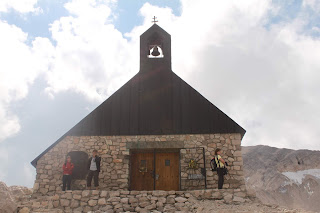In the summer of 2011, I spent over three weeks in Europe. The trip was planned to coincide with the 20th anniversary of my school reunion in Vienna. I covered six countries on that trip, namely Austria, Slovenia, Croatia, France, Slovakia and Germany. I had gotten engaged to Kamalini a couple of months earlier, and she joined me on the second half of my trip. We went on to marry later that year. Our travels around Germany on that trip were limited to Bavaria. We visited the town of Garmisch-Partenkirchen (where Kamalini's close Japanese friend from college, Noriyo, joined us from Frankfurt) and Munich. Our plan of visiting Neuschwanstein Castle had to be cancelled, because Kamalini fell ill from the exhaustion of our very hectic trip!
Garmisch-Partenkirchen is a town in Bavaria, with a population of 27,000. It lies close to Germany’s highest peak,
Zugspitze, and is about 100 km southwest of the Bavarian capital Munich.
Garmisch-Partenkirchen is a ski town and was the venue of the 1936 Winter Olympic Games. Garmisch (which lies to the
west) and Partenkirchen (which lies to the east) were actually two separate towns
that were united only in 1935 before the Winter Olympic Games. In the 16th century, Garmisch had its share of misfortune, with epidemics like the
bubonic plague. This led to a witch hunt, and 63 people were tried and
executed!!
The
town’s main church is the Neue Kirche. The church lies on the town's main square, Marienplatz, and construction was completed in 1752. It has a soaring bell tower visible from many parts of the town. It replaced the Alte Kirche.
 |
| Neue Kirche, Garmisch-Partenkirchen |
 |
| Marienplatz, Garmisch-Partenkirchen |
Several buildings in the town centre have their facades painted with typical Bavarian landscapes, snapshots from local village life, and religious scenes. Two beautiful examples are the facades of the clothing store Grasegger, and the building called Zum Schloapferer. I had noticed similar facade paintings on a previous trip to Neuschwanstein.
 |
| Grasegger, Garmisch-Partenkirchen |
 |
| Zum Schloapferer, Garmisch-Partenkirchen |
Zugspitze is the
highest peak in Germany at 2,962 meters. It lies close to
Garmisch-Partenkirchen and can be accessed by train and then cable car. There are in fact three cable cars that get
to the top. The peak was first climbed in 1820.
 |
| The Cable Car Ride to Zugspitze |
 |
| Cable Car to Zugspitze |
There is a cross at the summit of Zugspitze, marking out the highest point. There is also a small chapel at the top.
 |
| Cross at the summit of Zugspitze |
 |
| Chapel, Zugspitze |
 |
| Crucifixion statue inside the Chapel, Zugspitze |
Eibsee is a
lake 9 km southwest from Garmisch-Partenkirchen. The lake lies at the base of
Zugspitze, and a cable car takes visitors to the summit from Eibsee.
The lake has a maximum length of around 3 km and a maximum width of around 0.5 km.
 |
| Eibsee and Zugspitze |
We spent a day in Garmisch-Partenkirchen. We came in by train from Innsbruck in Austria, and in the evening we caught a train and carried on to Munich. It was a memorable day seeing the very pleasant town, going on a boat ride at the stunningly beautiful Eibsee, and taking a mountain train and a cable car to the summit of the majestic Zugspitze, with its breath-taking views of the serene surroundings!










No comments:
Post a Comment